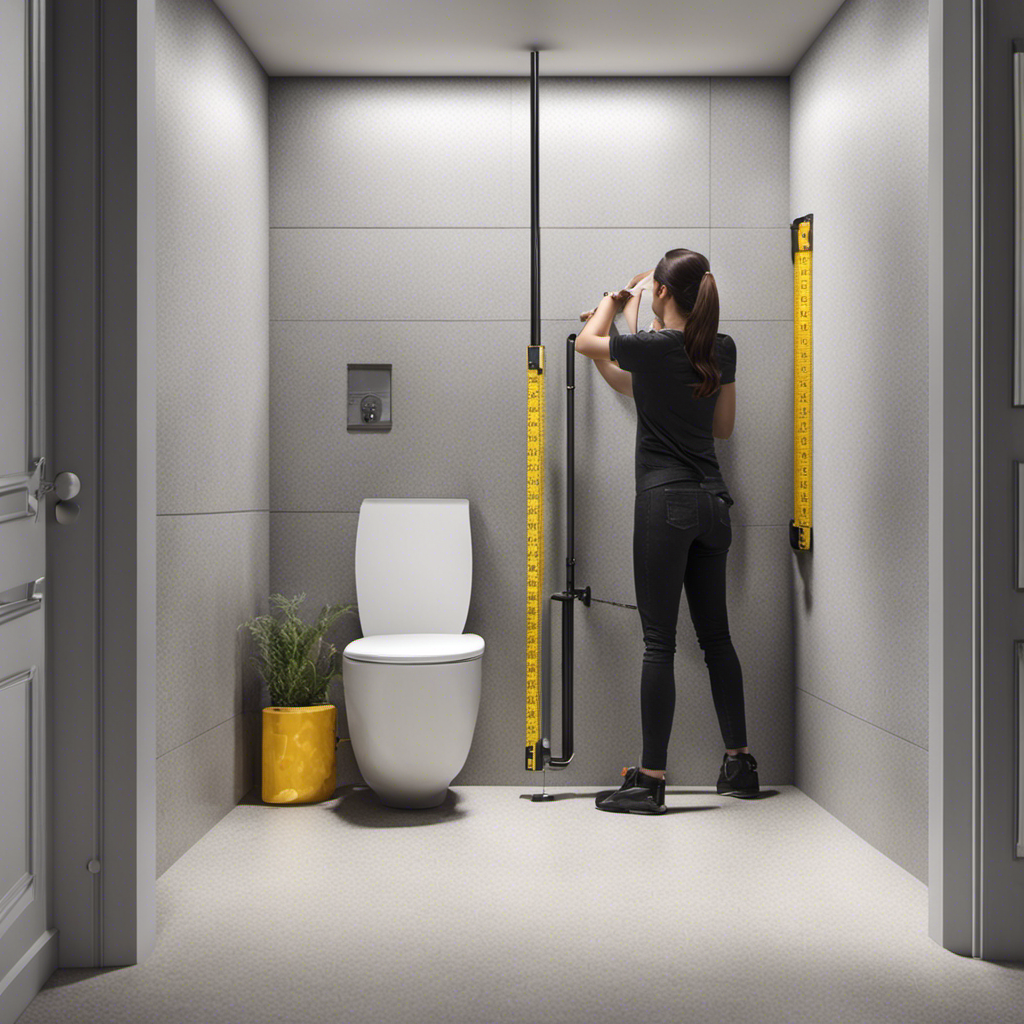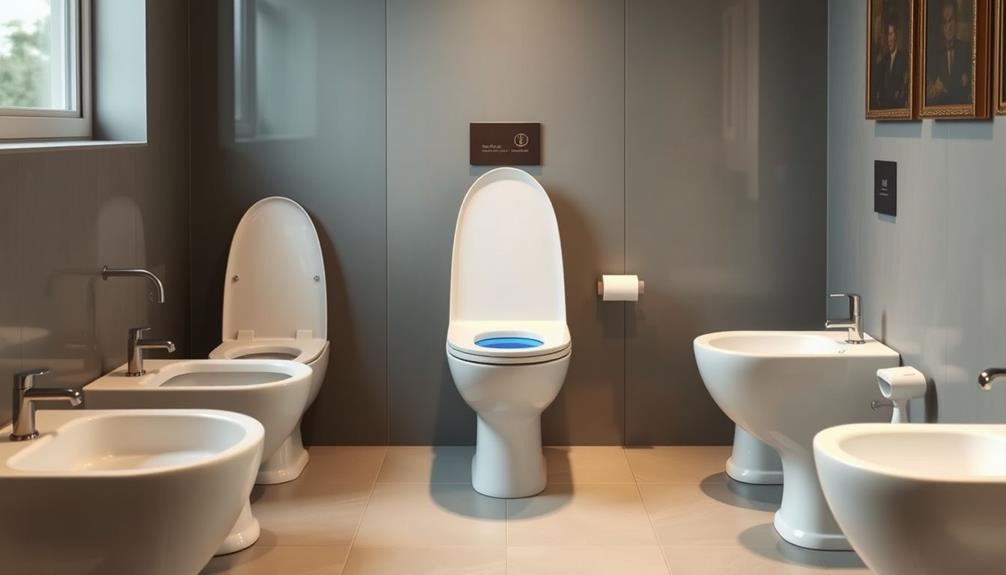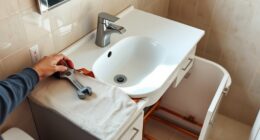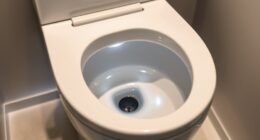I’ve got a real doozy for you today – a step-by-step guide on how to measure for a toilet.
Now, I know what you’re thinking, ‘Why do I need to measure a toilet?’
Well, let me tell you, accurate measurements are crucial for ensuring a perfect fit and avoiding any plumbing nightmares down the line.
So, grab your measuring tape and let’s dive into the nitty-gritty of measuring the rough-in, width, depth, height, and distance to the water supply.
Trust me, you’ll thank me later!
Key Takeaways
- Accurate measurements are crucial for a proper fit and installation of a toilet
- Use tools such as a tape measure, level, and wax ring for accurate measurements and installation
- Measure the rough-in distance and the width and depth of the toilet space for proper alignment and fit
- Consider the height of the toilet for comfort, accessibility, and safety
Why Accurate Measurements Matter
Accurate measurements matter because they ensure a proper fit for your toilet. When it comes to installing a toilet, precision is key. The importance of accurate measurements cannot be overstated.
One common measurement error to avoid is not measuring the rough-in properly. The rough-in refers to the distance from the wall to the center of the toilet flange.
Another mistake to avoid is failing to measure the space available for the toilet tank. This can lead to a toilet that protrudes too far into the room or doesn’t fit properly.
Additionally, it is crucial to measure the height of the existing toilet and the space between the flange and the wall. Neglecting these measurements can result in a toilet that is too high or too low.
Tools Needed for Measuring a Toilet
You’ll need a few tools to get the right measurements for installing a new toilet. Here are the essential tools needed for toilet installation:
-
Tape Measure: This tool is crucial for accurately measuring the dimensions of the bathroom space to determine the proper placement of the toilet.
-
Level: A level will ensure that the toilet is installed correctly and balanced, preventing any wobbling or leaks.
-
Wax Ring: Although not a traditional tool, a wax ring is essential for sealing the toilet to the floor and preventing any leaks.
To accurately measure the toilet flange, start by removing the old toilet and inspecting the flange. Use the tape measure to measure the diameter and height of the flange. It’s important to get precise measurements to ensure a proper fit for the new toilet.
Step-by-Step Guide to Measuring the Rough-In
First, make sure to remove the old toilet and examine the rough-in, as this will play a crucial role in determining the proper placement of your new toilet.
When it comes to measuring for a new toilet, it’s important to consider the optimal toilet size for your bathroom. To accurately measure the rough-in, you’ll need a measuring tape and a pencil.
Start by measuring the distance from the wall to the center of the closet bolts, which secure the toilet to the floor. This measurement will give you the rough-in size.
Next, measure the width and depth of the area where the toilet will be placed to ensure it will fit properly.
Measuring the Width and Depth of the Toilet Space
Now, take a moment to assess the width and depth of the space where your new toilet will be placed, ensuring that it will fit perfectly in your bathroom.
To accurately measure the dimensions of the toilet space, follow these steps:
-
Measure the width of the space from one side wall to the other. Use a tape measure and ensure it is level to get an accurate measurement.
-
Measure the depth of the space from the wall behind the toilet to the front edge of the area where the toilet will be placed. Again, use a tape measure and keep it level for precise measurements.
-
Take note of the toilet rough-in measurement, which is the distance from the wall to the center of the drainpipe. This measurement is crucial for selecting the right toilet that will align with your existing plumbing.
By accurately measuring the width and depth of the toilet space, as well as the rough-in measurement, you can confidently choose a toilet that will fit perfectly in your bathroom.
Now, let’s move on to determining the height of the toilet.
Determining the Height of the Toilet
When it comes to determining the height of a toilet, there are several key points to consider.
Firstly, the optimal toilet height is typically around 17 to 19 inches, which provides a comfortable and accessible seating position for most individuals.
Secondly, it is important to take into account the mobility of the user, as higher toilets may be more suitable for those with limited mobility or physical disabilities.
Lastly, installation space requirements should be considered, ensuring that there is enough room for the toilet to be properly installed and for the user to maneuver comfortably in the bathroom.
Optimal Toilet Height
To find the optimal height for your toilet, you should measure from the floor to the top of the bowl. This is crucial for ensuring optimal toilet design and accessibility.
Here are three key considerations to keep in mind when it comes to toilet height:
-
Comfort: The height of the toilet should be comfortable for users of all ages and abilities. A standard toilet height is around 15 inches, but for individuals with mobility issues, a higher toilet height of around 17-19 inches may be more suitable.
-
Accessibility: Optimal toilet design includes considering the needs of individuals with disabilities. Installing a taller toilet with appropriate grab bars can greatly improve accessibility and provide a safer bathroom experience.
-
Safety: A toilet that is too low can cause strain on the knees and back when sitting or standing up. On the other hand, a toilet that is too high can be uncomfortable and may lead to instability. Finding the right balance is essential for both safety and comfort.
Consideration for Mobility
One important consideration for individuals with mobility issues is ensuring that the toilet height is suitable for easy and comfortable use. The optimal seat height for a toilet is typically between 17 to 19 inches, allowing for a natural sitting position and minimal strain on the knees and hips.
An accessible design should also include features such as grab bars and a raised seat for added support and stability. To determine the appropriate toilet height, it is crucial to measure from the floor to the top of the seat. This measurement will help in selecting a toilet that meets the user’s specific needs.
By considering these factors, individuals with mobility issues can ensure that their toilet provides the necessary comfort and accessibility.
In the next section, we will discuss the installation space requirements for a toilet.
Installation Space Requirements
The optimal seat height for a toilet is typically between 17 to 19 inches, allowing for a natural sitting position and minimal strain on the knees and hips. When considering installation space requirements, it is important to ensure that there is enough room for the toilet to fit comfortably in the designated area.
Here are three key measurements to consider:
-
Depth: Measure the distance from the wall to the center of the toilet’s flange. This will determine how far the toilet will extend into the room.
-
Width: Measure the distance between the side walls or any other obstacles near the toilet. This will ensure that there is enough space for the toilet to fit without any obstructions.
-
Height: Measure the distance from the floor to the top of the toilet’s tank. This will determine if there is enough clearance for the toilet to fit under any overhanging cabinets or shelves.
Tips for Measuring the Distance to the Water Supply
First, make sure you’re using a flexible measuring tape to accurately determine the distance from the water supply to the toilet.
Start by locating the water supply, which is usually located behind or beside the toilet. Use the measuring tape to measure the distance from the center of the toilet’s flange to the center of the water supply valve. This will give you the proper measurement for the water supply location.
Keep in mind that the measurement should be taken in a straight line, without any curves or bends. Ensure that the measuring tape is held taut against the walls or any obstacles to get an accurate measurement.
Common Mistakes to Avoid When Measuring for a Toilet
When measuring for a toilet installation, it’s crucial to avoid common mistakes that can lead to inaccurate measurements. Accurate measurements are vital for ensuring the toilet fits properly in the designated space and functions correctly.
Here are three common measuring mistakes to avoid:
-
Not accounting for baseboard or trim: Forgetting to measure the height and width of baseboards or trim can result in an ill-fitting toilet that doesn’t sit flush against the wall.
-
Neglecting to measure the rough-in distance: The rough-in distance is the measurement from the wall to the center of the toilet drain. Failing to measure this accurately can lead to a toilet that doesn’t align with the existing plumbing.
-
Ignoring the clearance space: Overlooking the required clearance space around the toilet can result in cramped and uncomfortable conditions.
Accurate measurements are essential to ensure a smooth and successful toilet installation. Avoiding these common measuring mistakes will help you achieve a precise fit and optimal functionality.
Conclusion
In conclusion, accurate measurements are crucial when measuring for a toilet. By using the right tools and following a step-by-step guide, you can ensure a precise fit for your toilet.
Remember to measure the rough-in, width, depth, and height of the toilet space, as well as the distance to the water supply. Avoid common mistakes and take your time to get it right.
With careful measurement, you’ll have a perfectly fitted toilet that will bring comfort and convenience to your bathroom.










